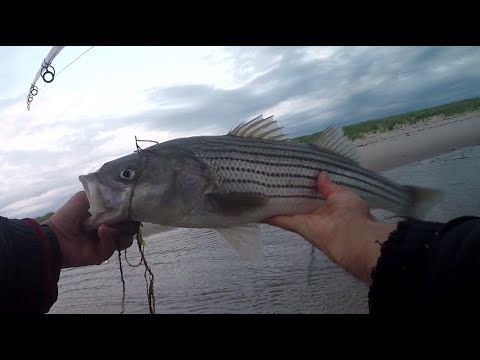Along with better weather, the last of the melting snow and the return of the osprey—every angler’s favorite bird—from their winter residence down south (like South America-south), spring has really sprung in the Northeast when the smallest of our striped friends make their first appearance after their long trip north. Migrating schoolie stripers signal the end of winter and the beginning of another year of fishing the salt with high hopes for record catches and even better fish stories.
When water temps hit the mid-50’s and the days grow longer, the striped bass (morone saxatilis), first the schoolies, followed by their bigger brethren, start to make the migration north from their winter homes in the Chesapeake and Hudson River. Stripers (an anadromous species) leave the salt to spawn in the fresh water, returning to the ocean to migrate north. Soon they’ll be here in search of spawning herring and other local bait.
Targeting schoolies is traditionally the kickoff to the saltwater fishing season in the Northeast and on the Cape. The fishing shows are over, you’re stocked up—check themightyfish.com if not—and it’s time to catch some stripers. Let’s talk tips, where to look and the lures and gear that will get you on the first fish of the season.
Tips:
Most important schoolie tip: CRUSH YOUR BARBS! These small fish are the future of the striped bass fishery and as responsible anglers, it’s our duty to release them with as little damage as possible. So, take your pliers—you do have them, don’t you? and crush down on the barbs to ensure easy and quick releases. You should always fish for schoolies with single hooks only. Leave the 4/0 trebles for the big girls who’ll be coming to the party in June. If you keep the line tight on appropriately sized gear, you’ll land just as many fish as with multiple treble hook set ups. And, remember to keep these little guys wet as much as possible. They’ve come a long way and it’s best to keep the stress on them to a minimum.
Where to look:
Moving water, structure and baitfish. Find any of these, or better yet, a combination, or all three and when the schoolies are here, you’ll find them. Look for rivers with herring runs and work the moving tides. There are even a couple of Cape rivers that are named after certain baitfish and stripers themselves that might be worth a shot! Harbors and jetties provide great structure and for night fishing, lights will concentrate bait for stealth schoolies to pick off. Another favorite spot for these little stripers are the acres of estuaries and marshes of Cape Cod. Find spots to walk in (wear boots and be careful of the quicksand like muck) and you’ll have endless opportunities to chase schoolies through the rivers and salt ponds that hold herring. Working these back bay areas for small stripers are one of the truly great types of fishing that we get each year.
Lures:
Our favorite and most successful way to target schoolie stripers is with the many great soft plastics available to saltwater fishermen. In general, we stick to the white/bone color, with silver and chartreuse (a schoolie favorite) also in our bag. At the Goose, we recommend both eel and paddle tail lures, such as small RonZ’s, Savage sand eels, small Al Gag’s Whip-It Fish (try the Underspin for some extra flash), Bill Hurley sand eels, or rig your own using Zoom bodies with ¼ - ½ oz. jig heads. If you’re a bucktail guy, many anglers will use ½ - ¾ oz. bucktails working them in the current. Just make sure that the hook isn’t too big for these fish, some of which can be tiny. And always crush those barbs!
Gear:
For sporting fun and to keep stress on the fish to a minimum, make sure you scale down your rod and reel. For these small stripers, you don’t need your heavy 11’ canal setup. Many anglers will even use their favorite freshwater gear. Not a bad idea, based on where you’re fishing and how far you need to cast.
We’d recommend that you look at a 7’ to 7’6” medium weight inshore rod with a 3000 to 4000 size reel. If you’re going to be fishing lots of docks and jetties, and will be pulling the fish up, you might want to go medium-heavy. Certain situations may call for an 8’ surf setup, which you’ll find to be a good all around size for targeting albies and schoolies again in the fall.
Some of our favorite schoolie rods are Tsunami’s new Carbon Shield II line, Shimano’s Talavera or Teramar and as upgrade pick, St. Croix’s proven Tidemaster series. If you’re interested in a surf-style rod, look no further than St. Croix for the performance and warranty with the Triumph, Mojo or even Avid in a 7’ or 8’ size. All of these are great rods that will have a place in your arsenal all season long. Come into the Goose and we’ll show you these great options and more.
For a reel, consider options from Shimano, with the Sedona being a good pick at a great price. For an upgrade, take a look at a Stradic for incredible performance and bang for the buck. We also like the Tsunami Shield reels—sealed and perfect for a budget setup. Another good option would be the old reliable Penn Spinfisher series and of course, there are many others at all price ranges. As for line, our favorite at the Shop is PowerPro Super Slick, with 20 lb. being an ideal size for schoolies.
So, that’s a lot of information for some little fish! But, there’s nothing better and maybe more memorable than catching that first schoolie striper of the year. Spring will soon be here, so gear up and catch ‘em up!

